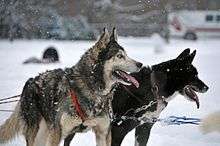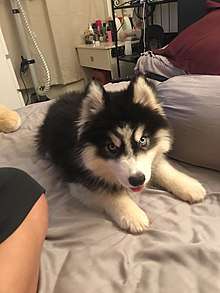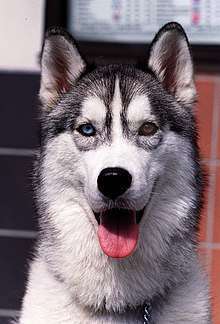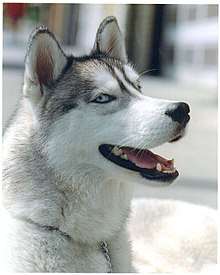Husky
A husky is a sled dog used in the polar regions. One can differentiate huskies from other dog types by their fast pulling-style. They represent an ever-changing crossbreed of the fastest dogs[1] (the Alaskan Malamute, by contrast, pulled heavier loads).[2] Humans use huskies in sled-dog racing. In recent years,various companies have marketed tourist treks with dog sledges for adventure travelers in snow regions.[3] Huskies are also kept as pets, and groups work to find new pet homes for retired racing and adventure-trekking dogs.[4]


Etymology
The word husky originated from the word referring to aboriginal Arctic people, in general, Eskimo, "...known as 'huskies', a contraction of 'Huskimos', the pronunciation given to the word 'Eskimos' by the English sailors of trading vessels."[5] The use of husky is recorded from 1852 for dogs kept by Inuit people.[6]
Lineage
Nearly all dogs' genetic closeness to the gray wolf is due to admixture.[7] However, several Arctic breeds also show a genetic closeness with the now-extinct Taimyr wolf of North Asia due to admixture: the Siberian Husky and Greenland Dog (which are also historically associated with Arctic human populations) and to a lesser extent, the Shar Pei and Finnish Spitz. An admixture graph of the Greenland Dog indicates a best-fit of 3.5% shared material; however, an ancestry proportion ranging between 1.4% and 27.3% is consistent with the data and indicates admixture between the Taimyr wolf and the ancestors of these four high-latitude breeds.
This introgression could have provided early dogs living in high latitudes with phenotypic variation beneficial for adaption to a new and challenging environment, contributing significantly to the development of the husky. It also indicates that the ancestry of present-day dog breeds descends from more than one region.[8]
Characteristics

Huskies are energetic and athletic. They usually have a thick double coat that can be gray, black, copper red, or white.[9]. The double coat generally protects huskies against harsh winters and, contrary to what most believe, they can survive in hotter climates. During the hotter climates, huskies tend to shed their undercoat regularly to cool their bodies. In addition to shedding, huskies control their eating habits based on the season; in cooler climates, they tend to eat generous amounts, causing their digestion to generate heat, whilst in warmer climates, they eat less. Their eyes are typically pale blue, although they may also be brown, green, blue, yellow, or heterochromic. Huskies are more prone to some degree of uveitis than most other breeds.[10]
Breeds

Husky-type dogs originally were dog landraces kept by the Arctic indigenous peoples.[11]
Examples of these landraces in modern times have been selectively bred and registered with various kennel clubs as modern purebred breeds, including the Siberian Husky and the Labrador Husky. The Sakhalin Husky is a extinct Japanese sled dog related to the Japanese Spitz and the Akita Inu.
The Mackenzie River husky is a dog subtype referring to different dog populations in the subarctic regions of the American state of Alaska and Canada.
The Alaskan husky is not considered a pure breed, but is instead another subtype. It is defined only by its purpose, which is that of a highly efficient sled dog.
Alternative activities
Since many owners now have huskies as pets in settings that are not ideal for sledding, other activities have been found that are good for the dog and fun for the owner.
- Skijoring is an alternative to sled pulling, but mainly used in somewhat the same environment, as sledding with the exception that the owner (cross-country skier) does not need a full pack in order to participate.
- Dog hiking is an alternative for owners who live closer to woodland trails. The owner travels with their dogs along trails in the wilderness. This activity allows the owner and dog to gain exercise without using the huskies' strong sense of pulling. Some companies make hiking equipment especially for dogs in which they may carry their own gear, including water, food, and bowls for each.
- Carting, also known as dryland mushing or sulky driving, is an urban alternative to dog sledding. Here, the dog can pull a cart that contains either supplies or an individual. These carts can be bought or handmade by the individual.
- Bikejoring is an activity where the owner bikes along with their dog while they are attached to their bike through a harness which keeps both the dog and owner safe. The dog or team of dogs can be attached to a towline to also pull the biker.
In popular culture
- The phrase three dog night, meaning it is so cold you would need three dogs in bed with you to keep warm, originated with the Chukchi people of Siberia, who kept the Siberian husky landrace dog that became the modern purebred breed called the Siberian Husky.[12]
- Huskies are the mascots of several post-secondary institutions in the United States, including the University of Washington,[13] the University of Connecticut, the Houston Baptist University, Bloomsburg University of Pennsylvania, Northeastern University, Michigan Technological University, Northern Illinois University,[14] St. Cloud State University,[15] University of Southern Maine,[16] and the University of Wisconsin-Marathon County.[17] They are also the mascots for Saint Mary's University (Halifax),[18] George Brown College (Toronto),[19] and the University of Saskatchewan in Canada.[20]
- The World War II Allied invasion of Sicily in 1943 was called "Operation Husky".[21]
- Sledding huskies have been featured in motion pictures, including Eight Below, Iron Will, and Snow Dogs, and in the animated film Balto.
- The Twilight Saga, which features werewolves, and the TV series Game of Thrones, which heavily featured dire wolves during season one, are thought to have inspired a surge in popularity for husky breeds; however, animal charities have also seen a massive increase in owners abandoning the dogs as they become too difficult.[22][23][24][25]
- The 2019 Entertainment Studios computer animated film Arctic Justice: Thunder Squad features two huskies as some of its main characters.
References
| Look up husky in Wiktionary, the free dictionary. |
- Schultz, Jeff (28 January 2003). Dogs of the Iditarod. Seattle: Sasquatch Books. p. 41. ISBN 1-57061-292-7.
- D. K. (2013-10-01). The dog encyclopedia. Dennis-Bryan, Kim, Baggaley, Ann, John, Katie, DK Publishing, Inc. (First American ed.). New York. p. 103. ISBN 9781465421166. OCLC 859155647.
- Neary, Kathleen (2008-01-14). "How Sled Dogs Work". Retrieved 3 June 2015.
- Keith, Christie (18 February 2011). "Lessons from a sled dog massacre". sfgate. Retrieved 3 June 2015.
- Dictionary of Newfoundland English, by George Morley Story, W. J. Kirwin, John David Allison Widdowson, pg 263, University of Toronto Press 2004, ISBN 0-8020-6819-7
- "Definition of HUSKY". www.merriam-webster.com. Retrieved 2017-08-30.
- Freedman, A. H.; Gronau, I.; Schweizer, R. M.; Ortega-Del Vecchyo, D.; Han, E.; Silva, P. M.; Galaverni, M.; Fan, Z.; Marx, P.; Lorente-Galdos, B.; Beale, H.; Ramirez, O.; Hormozdiari, F.; Alkan, C.; Vilà, C.; Squire, K.; Geffen, E.; Kusak, J.; Boyko, A. R.; Parker, H. G.; Lee, C.; Tadigotla, V.; Siepel, A.; Bustamante, C. D.; Harkins, T. T.; Nelson, S. F.; Ostrander, E. A.; Marques-Bonet, T.; Wayne, R. K.; Novembre, J. (2014). "Genome Sequencing Highlights the Dynamic Early History of Dogs". PLoS Genetics. 10 (1): e1004016. doi:10.1371/journal.pgen.1004016. PMC 3894170. PMID 24453982.
- Skoglund, P.; Ersmark, E.; Palkopoulou, E.; Dalén, L. (2015). "Ancient Wolf Genome Reveals an Early Divergence of Domestic Dog Ancestors and Admixture into High-Latitude Breeds". Current Biology. 25 (11): 1515–9. doi:10.1016/j.cub.2015.04.019. PMID 26004765.
- The Oxford Pocket Dictionary of Current English 2009 online http://www.encyclopedia.com/topic/husky.aspx
- Uveodermatologic syndrome, http://www.vetmed.ucdavis.edu/courses/vet_eyes/conotes/con_chapter_11.html Archived 2012-06-06 at the Wayback Machine
- Little Wolf, Stephanie. "A Deeper History of the Origins of The Alaskan Husky". Retrieved 3 June 2015.
- William James Burroughs (2005). Climate Change in Prehistory: The End of the Reign of Chaos. Cambridge; New York: Cambridge University Press. p. 129. ISBN 0-521-82409-5.
- "University of Washington Athletics". University of Washington Athletics. Retrieved 4 January 2018.
- Arnold, Brandy. "US Colleges & Universities with Dogs for Mascots". The Doginton Post. Retrieved 29 July 2014.
- "Husky Athletics and Recreation". St. Cloud State University. Retrieved 29 July 2014.
- "Campus Life". University of Southern Maine. Archived from the original on 29 July 2014. Retrieved 29 July 2014.
- "UWMC unveils new Husky mascot". University of Wisconsin - Marathon County. Archived from the original on 9 August 2014. Retrieved 29 July 2014.
- "Saint Mary's This Week". Saint Mary's University. Archived from the original on 4 March 2016. Retrieved 29 July 2014.
- "George Brown Athletics". George Brown College. Archived from the original on 29 July 2018. Retrieved 29 July 2014.
- Davis, Tim. "Week 14 - Huskie Athletics Top 100 Moments". Independent Sports News. Archived from the original on 10 August 2014. Retrieved 29 July 2014.
- "Operation husky: Sicily - 9/10 July 1943". Combined Operations Command. Retrieved 29 July 2014.
- O'Brien, Liam (2012-12-26). "Game of Thrones inspired Huskie craze goes cold as owners give up on dogs". The Independent. The Independent. Retrieved 29 July 2014.
- "Pet 'fashion victims' on the rise, warns Blue Cross". Blue Cross. Archived from the original on 29 July 2014. Retrieved 29 July 2014.
- "How Game of Thrones Influences Breed Trends". Pet360. Archived from the original on 10 July 2017. Retrieved 29 July 2014.
- "'Game of Thrones': Bronn Actor Begs Fans to Stop Buying Huskies That Look Like Direwolves (Video)". The Wrap. April 11, 2019. Retrieved April 14, 2019.